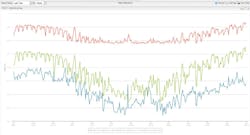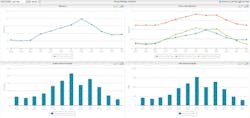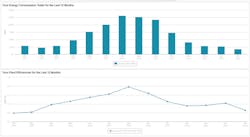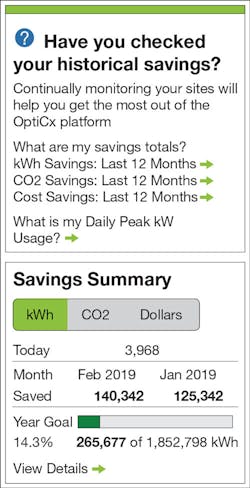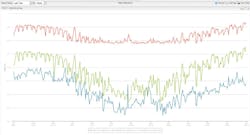Why M&V is Key to Optimizing HVAC Systems
By FREDERICK WOO, Optimum Energy, Seattle WA
Measurement and verification (M&V) is the foundation of successful HVAC optimization projects. Getting it right means hitting your ROI and energy savings targets. Getting it wrong can mean missing out on hundreds of thousands—even millions—of dollars in savings over time.
To paraphrase Peter Drucker, you cannot optimize what you cannot measure. Measuring and verifying both the energy input and the system output is essential for data-based optimization (which delivers the biggest savings), because varying the energy input of any piece of equipment will vary the total system output. Even in manually operated systems, enabling operators to see the effects of their actions on system efficiency will affect their behavior.
Holistic, automatic optimization of HVAC systems typically increases energy efficiency by an additional 10 to 25 percent over just installing new equipment. And true optimization is a real-time dynamic process, based on real-time inputs, not a static set-and-forget process. Without an accurate measure of how much energy each piece of the equipment in the HVAC system is using, it is impossible to accurately predict and report the impact of varying conditions on the system, fight performance drift, or nail the other aspects of optimization.
The best way to set up M&V for HVAC optimization is to start with a road map for the project developed in partnership with the contractors who will do the work.
The Blueprint for Optimization
M&V starts with setting up your HVAC system so that you are able to measure equipment consumption and output. When assessing plant components in order to measure power draws and efficiency, ask:
• Are there enough sensors to measure efficiency consistently across sites? Additional power meters or equipment networking may be needed in order to measure the power draw of each piece of equipment;
• Are all critical sensors in the right place, and are they properly calibrated? This includes flow meters, pressure sensors, temperature sensors, and any other sensor needed to measure equipment output. Many plants require new piping, temperature sensors, or flow meters to support optimization. We often run into people who say that their plant is operating at a seemingly arbitrary efficiency, such as 0.7 kW/ton. When asked how they gathered that data without flow meters or power meters, they say, “I guessed,” or, “I measured once.” Those approximations are usually not sufficient to justify investing in an optimization project;
• Are variable frequency drives (VFDs) networked to a system that can collect and present the data? Do the drives have a kW point, and is it included in the networked points?;
• Will the proposed M&V method provide relevant reports? M&V software should compile data from the equipment and report on the effectiveness of optimization in relation to business and sustainability goals in an easy-to-retrieve format.
How M&V Assures Results
It’s hard to justify the budget for an optimization project if predicted results can’t be quantified and verified—savings estimates based on shaky data can be way off, leading to the perceived failure of an otherwise successful optimization project. This can happen when a facility doesn’t have a reliable energy baseline, which leads to uncertain estimates (see the flow meter problem noted above), or when the optimization project does not build in a continuous improvement process.
Project leaders can prevent these problems by taking these steps:
• Before moving forward with a project, correlate all power draws with the facility’s utility bills. Also, vet the energy model the vendor employs, and understand the assumptions it is based on;
• Make sure that all HVAC equipment is modeled and its energy impact is accounted for. Watch out for unintended consequences from incomplete optimization. For example, it is possible to optimize the chilled water temperature to save energy on the chillers, but then cause the air handler fans to ramp up to counter an overly ambitious chilled water reset, resulting in more total energy usage across your building;
• Make continuous monitoring part of the project and future annual budgets. The energy savings from properly maintaining and monitoring the optimization system often outweigh maintenance and subscription fees;
• Have an internal champion who understands where the savings come from and the technology involved, who has seen it in action and knows how to use it. This person should also understand how to access and interpret the data. A lack of buy-in from the facility operations team can lead to manual system operation and de-optimization.
The Human Touch
Getting operators and facilities engineers on board with new techniques and practices is essential for success. Provide training, and possibly visits to other optimized facilities, as early in the project as possible. In addition to creating buy-in, this early involvement can generate insights on optimization factors that might be overlooked without the input of the people who operate the building.
Since continuous HVAC monitoring is important to achieving consistent savings over time, operations staff should be armed with tools for ongoing M&V that allow them to detect and resolve issues as they happen. This ensures that the optimization solution can continue to meet energy and cost savings targets even as the plant ages.
With an HVAC optimization project built on thorough, thoughtful M&V, you can be confident that you’ll hit your energy efficiency and cost savings goals many years into the future.
Based in Seattle, the author is Manager of Engineering for Optimum Energy. A mechanical engineer with 15 years of experience in energy efficiency, HVAC controls, energy management systems, and Web-based data collection, he manages a team of 10 engineers who perform detailed assessments of public and commercial facility HVAC systems.
